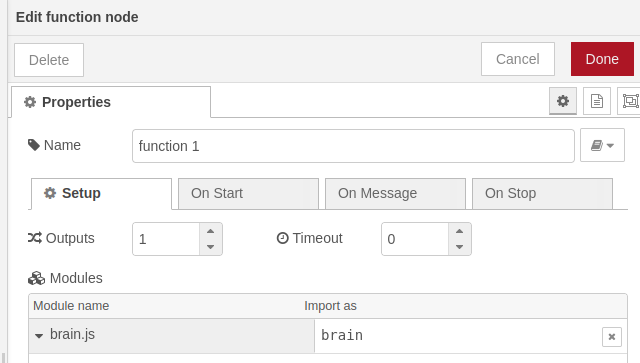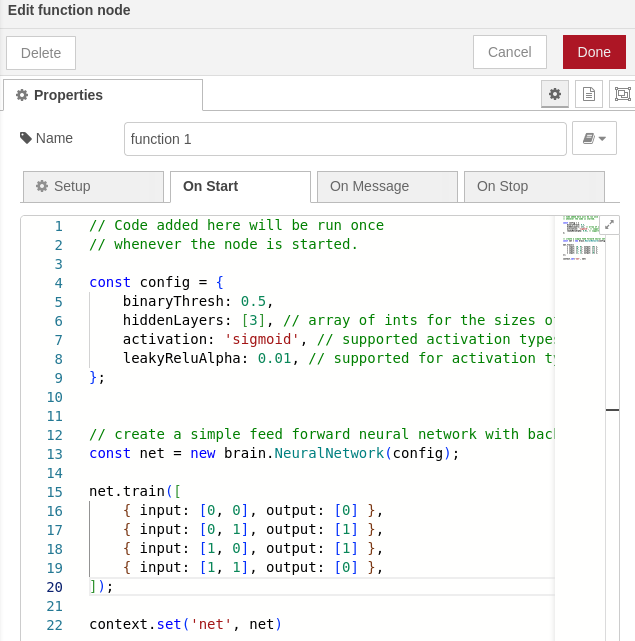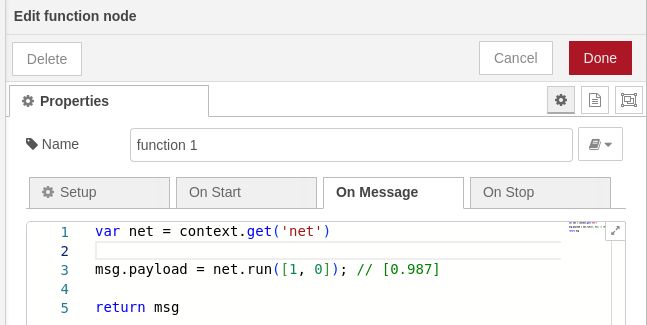Integracja brain.js z Node-Red
Dlaczego?
Dla zabawy i poznania Node-Red. Pomyślałem sobie, że fajnie było by mieć “czarną skrzynkę’, która wyrzuci mi wynik dla zadanych parametrów. Np. na wejściu mam:
- Nie ma mnie w domu
- Wykryto człowieka
- Alarm jest włączony
I dostaję na wyjściu
- tak, wyślij wiadomość
Oczywiście na wejściu będzie więcej parametrów
A więc padło na sieci neuronowe.
brain.js
Znalazłem sobie taką bibliotekę, dla starszych wersji były też gotowe rozwiązania dla Node-Red. Niestety nie znalazłem nic gotowego do użycia w 2024. Tak czy inaczej. Kilka stron do czytania i mam gotowy przykład.
How to install
Lecimy do katalogu ~/.node-red, to ten w którym mam lib, node_modules i settings.js i odpalamy tam:
npm i brain.js
Następnie edytujemy settings.js. Szukamy functionGlobalContext i dodajemy brain.js, powinno to wyglądać mniej więcej tak:
functionGlobalContext: {
// os:require('os'),
brainjs:require('brain.js')
}
No i restart.
Example
Przykład jest banalny:

Function node
Oczywiście to nie jest cel, który chciałem osiągnąć, ale dostałem ważną informację, działa.
Setup
Wczytujemy brain.js

On Start
Tutaj tworzymy sieć i ją uczymy. Zrobimy to raz po starcie.

On Message
A teraz tylko odpalamy sieć dla parametrów wejściowych i rezultat wysyłamy dalej.

Exported flow
[
{
"id": "4f7b8a1ffd9af2d2",
"type": "tab",
"label": "Flow 1",
"disabled": false,
"info": "",
"env": []
},
{
"id": "4403444239c81a4f",
"type": "inject",
"z": "4f7b8a1ffd9af2d2",
"name": "",
"props": [
{
"p": "payload"
},
{
"p": "topic",
"vt": "str"
}
],
"repeat": "",
"crontab": "",
"once": false,
"onceDelay": 0.1,
"topic": "",
"payload": "",
"payloadType": "date",
"x": 120,
"y": 80,
"wires": [
[
"28b6e4a5c8517672"
]
]
},
{
"id": "28b6e4a5c8517672",
"type": "function",
"z": "4f7b8a1ffd9af2d2",
"name": "function 1",
"func": "var net = context.get('net')\n\nmsg.payload = net.run([1, 0]); // [0.987]\n\nreturn msg",
"outputs": 1,
"timeout": 0,
"noerr": 0,
"initialize": "// Code added here will be run once\n// whenever the node is started.\n\nconst config = {\n binaryThresh: 0.5,\n hiddenLayers: [3], // array of ints for the sizes of the hidden layers in the network\n activation: 'sigmoid', // supported activation types: ['sigmoid', 'relu', 'leaky-relu', 'tanh'],\n leakyReluAlpha: 0.01, // supported for activation type 'leaky-relu'\n};\n\n\n// create a simple feed forward neural network with backpropagation\nconst net = new brain.NeuralNetwork(config);\n\nnet.train([\n { input: [0, 0], output: [0] },\n { input: [0, 1], output: [1] },\n { input: [1, 0], output: [1] },\n { input: [1, 1], output: [0] },\n]);\n\ncontext.set('net', net)",
"finalize": "",
"libs": [
{
"var": "brain",
"module": "brain.js"
}
],
"x": 300,
"y": 80,
"wires": [
[
"3820ad2482c3582c"
]
]
},
{
"id": "3820ad2482c3582c",
"type": "debug",
"z": "4f7b8a1ffd9af2d2",
"name": "debug 1",
"active": true,
"tosidebar": true,
"console": true,
"tostatus": false,
"complete": "true",
"targetType": "full",
"statusVal": "",
"statusType": "auto",
"x": 490,
"y": 80,
"wires": []
}
]
Sources
Linki które mi pomogły:
- https://github.com/BrainJS/brain.js
- https://github.com/BrainJS/brain.js/issues/245
- https://flows.nodered.org/flow/195773d3b493d81c9bf012f64da02ea3